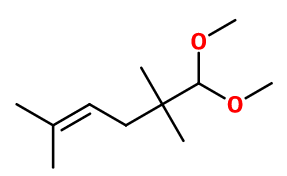Utilisation :
Le Méthyl Pamplemousse® est utilisé dans tous types de parfums, dans les eaux fraiches et les savons notamment (pour sa stabilité), pour des notes de pamplemousse rose. Apporte de la naturalité à un pamplemousse. Utilisé dans des notes fougères, chyprées et fruitées, pour en booster la tête. Apporte de la modernité aux citrus.
Autres noms :
Grapefruit Acétal, Amarocite®, 6,6-dimethoxy-2,5,5-trimethylhex-2-ene, 1,1-dimethox-2,2,5-trimethy-4-hexene, 1,1-dimethoxy-2,2,5-trimethyl hex-4-ene, 6,6-dimethoxy-2,5,5-trimethyl-2-hexene, methyl pomello, pamplerom, pomelocit
Commentaires et anecdotes :
En comparaison à certaines notes santalées comme le Bacdanol® ou le Sandalore®, le Méthyl Pamplemousse® possède une note avant tout fruitée, et une sous-note boisée.





Commentaires :
The limit only applies to applications on skin exposed to sunshine, excluding rinse-off products (please refer to Table 4 of the QRA booklet for more detailed information). If combinations of phototoxic fragrance ingredients are used, the use levels have to be reduced accordingly. The sum of the concentrations of all phototoxic ingredients, expressed in % of their recommended maximum level in the consumer product shall not exceed 100. Note: See remark on phototoxic ingredients in the Introduction to the IFRA Standards (Appendix 8 to the IFRA Code of Practice) and the Standard on Citrus oil and other furocoumarins-containing essential oils.